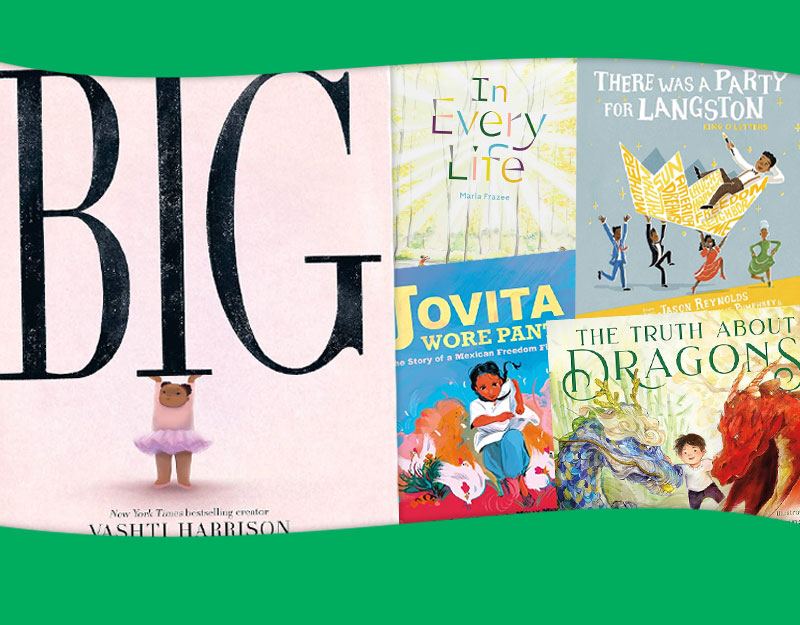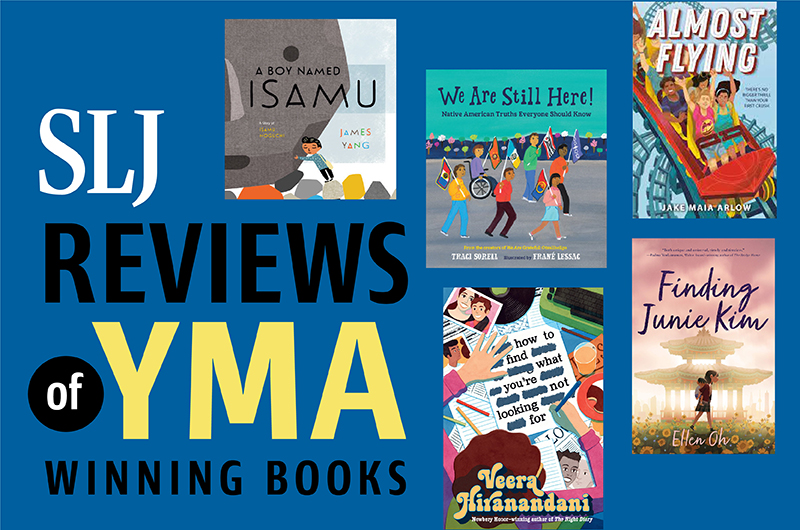2012 Robert F. Sibert Informational Book Medal Winner: Balloons over Broadway
Balloons over Broadway
Written and illustrated by Melissa Sweet
Published by Houghton Mifflin Books for Children, 2011
ISBN # 9780547199450
Grades 3 and up
Book Review
This year’s Sibert Award winner for nonfiction is a celebration of a celebration—or specifically, the man who made the annual Macy’s Thanksgiving Day Parade one of the most jubilant yearly events of the last century. In Balloons over Broadway, Caldecott Honor artist Melissa Sweet introduces us to Tony Sarg, the self-taught puppeteer who created the enormous half balloon, half puppets that distinguish the Macy’s parade from other holiday festivities. Mixing amusing side commentary (a wooden puppet explains that “Sarg rhymes with aargh!”) with nudging questions (“Still, how would Tony make his big puppets move?”), Sweet traces Sarg’s journey from a childhood of creativity and resourcefulness to his groundbreaking success as what many consider the Father of American Puppetry. But what truly infuses this picture book biography with joy from end page to end page is Sweet’s mixed media illustrations. With its joyful palette and plethora of whimsical figures, Sweet’s artistic style might as well be eponymous. Sweet also provides enough instructive diagrams, including excerpts from Sarg’s own sketches and samples of his creations, to pique even the most passive puppet fan’s interest. Take note, too, of the surprising double page spread that demonstrates Sarg’s breakthrough of puppet engineering. Share this book in your classroom, and watch everyone join the celebration.
Teaching Invitations
- Tony Sarg, the Complete Artist. Tony Sarg was not just an innovative puppeteer; he was also a toy designer, animator, and author and illustrator of dozens of children’s books. Invite your students to conduct more research on this prolific artist to build a more complete picture of his accomplishments. See the article in New York Magazine about Sarg’s illustrations and the various titles and websites listed below in Further Explorations.
- Puppets and Storytelling. Puppets have been used to tell and act out stories throughout history. Furthermore, using puppets is a popular way to engage students in storytelling in the classroom. They also help students practice their fluency and prosody skills. Use the resources listed in Further Explorations, such as the Jim Henson videos and “Storytelling with Puppets” to help your students create puppets and practice storytelling. The Puppeteers Cooperative (http://puppetco-op.org) has dozens of sets of instructions for building your own puppets, from hand puppets to life-size ones.
- The People Behind the Puppets. In her author’s note, Melissa Sweet explains that much of Tony Sarg’s success was due to the work of his talented apprentices. In fact, she traces the master-apprentice relationship from Sarg all the way to Jim Henson, creator of the Muppets. Engage your students in explorations about these apprentices to learn more about the people behind the puppets. Use the books listed in the Further Explorations section below, and watch Being Elmo, the documentary about Kevin Clash, the soft-spoken man behind one of today’s most popular puppets, who likewise apprenticed under Jim Henson to continue Sarg’s lineage.
- Puppetry across Cultures. Sweet mentions that Sarg was inspired by an Indonesian rod puppet to create the parade’s first balloons, but puppetry has been an art form in various cultures across the world throughout history. Invite your students to explore the puppetry of different cultures, comparing and contrasting them with each other as well as Sarg’s creations. For what purposes are the puppets used? What materials are used to make them? Finally, challenge your students to create puppets inspired by diverse cultures and display them throughout the school.
- Community Parades. Engage your students in a study of their local community parades. Visit your local library and have them research the various parades, their purposes, their routes, and their histories, with particular attention to how the parades have evolved over time. If they have families or neighbors who are longtime residents of the community, encourage students to interview them about the parades and perhaps view old photographs of them. Create a book or website in which the class compiles its findings to share with local community members.
- Focused Biographies. Although biographies are technically narrated accounts of a person’s life, many biographies actually concentrate on one of two significant events that the person experienced. This is often the case with picture book biographies, such as Balloons over Broadway, which focuses only on the events related to Tony Sarg’s creation of the Macy’s Parade balloons. Using this as a mentor text, have your students write a biography or perhaps an autobiography that centers on one important occasion in the subject’s life. For comparison, share with them Kathleen Krull’s biography of Jim Henson (see citation in the Further Explorations section). You may even want to challenge them to write and illustrate that biography as a picture book to share with the class.
- Nonfiction Book Awards. Balloons over Broadway has garnered two prestigious awards for excellence in a nonfiction children’s book: the Sibert Medal from the American Library Association, and the Orbus Pictus Award from the National Council of Teachers of English. Compare and contrast the criteria for the Sibert Medal and the Orbus Pictus Award, and determine how this book meets those criteria. Invite students to study books that won honorable mention and other books that won in past years. Then, have your students apply those criteria to a vast swath of nonfiction books for children and young adults to build their skills for evaluating literature.
Critical Literacy
- What Makes an American Celebration? The Macy’s Parade began as a tribute to its immigrant employees. Additionally, Sweet notes that Tony Sarg was an immigrant, although little attention is given to his own cultural roots. Why do you think Sweet does this? What other significant contributions to American cultural celebrations have been made by immigrants? What makes something an “American” tradition if its basis is an immigrant experience? Moreover, why are some cultural celebrations and parades–such those for St. Patrick’s Day–embraced across the country, while others–like the Chinese New Year–are relegated to specific regions or parts of town? Invite students to explore these questions.
- The Economic, Social, and Cultural Capital of Puppeteers. Many people enjoy the entertainment provided by puppeteers, but relatively few actually aspire to become one and pursue a career in puppetry. And of those that do, stories of those like Tony Sarg and Jim Henson are rare. Given the feats of creativity and engineering–and the possibility for fame and cultural contribution involved, why is this so? How are puppets and puppeteers viewed socially or professionally in various cultures? What are the economic realities of puppeteers, as well as the economic contributions of their craft? Given the resurgence of popular interest in the Muppet franchise, are there some forms of puppetry that are more acceptable or appreciated than others? How so? In a way, these questions apply to all who pursue art and entertainment in their careers and are important to understanding what diverse cultures value.
Further Explorations
Online Resources
Robert F. Sibert Informational Book Medal – American Library Association
http://www.ala.org/alsc/awardsgrants/bookmedia/sibertmedal
Orbus Pictus Award – National Council of Teachers of English
http://www.ncte.org/awards/orbispictus
Melissa Sweet’s website
http://melissasweet.net
Balloons over Broadway activity kit
http://www.hmhbooks.com/kids/resources/BalloonsOverBroadway_ActivityKit.pdf
Official Macy’s Thanksgiving Day Parade website
http://www.macys.com/parade
Puppeteers of America
http://www.puppeteers.org
The Puppeteers Cooperative
http://puppetco-op.org
Tony Sarg – entry by Twin Cities Puppeteers
http://www.tcpuppet.org/NewFiles/Sarg.html
Being Elmo – information about the documentary about Kevin Clash, the Sesame Street puppeteer
http://beingelmo.com
How Stuff Works – Helium Balloons
http://www.howstuffworks.com/helium.htm
How Stuff Works – Macy’s Thanksgiving Day Parade
http://tlc.howstuffworks.com/family/macys-thanksgiving-day-parade.htm
“The Zooming Twenties” – article in New York Magazine on Tony Sarg’s illustrations
http://nymag.com/arts/books/features/29703/
Storytelling with Puppets
http://www.libsci.sc.edu/storytelling/techniques/collinspuppethanout.pdf
Storyteller.net
http://www.storyteller.net/
Jim Henson videos about puppet making
http://www.youtube.com/watch?v=AC440k6iByA
http://www.youtube.com/watch?v=B7JFw-9QUrs
Books
Corey, S. (2002). Milly and the Macy’s Parade. New York: Scholastic.
- This appealing picture book provides a historically fictive account of the origins of the Macy’s Thanksgiving Day Parade.
Huser, G. (2005). Stitches. Toronto, ONT: Groundwood Books.
- A historical fiction chapter book about a young boy who faces bullying and social discrimination as he attempts to stage a puppet production of A Midsummer Night’s Dream.
Krull, K. (2011). Jim Henson: The guy who played with puppets. New York: Random House.
- A picture book biography of the famous creator of the Muppets.
Love, D. A. (2004). The puppeteer’s apprentice. New York: Margaret K. McElderry Books.
- A historical fiction chapter book set in medieval England about a girl who dreams of becoming a puppeteer. The author’s note at the end includes a history of puppetry throughout the centuries.
Madden, S. (2001). America’s parade: A celebration of Macy’s Thanksgiving Day Parade. New York: TimeLife Books.
- An amazing collection of photographs of the Macy’s Parade from the Life Magazine archives.
McIsaac, F. J. & Stoddard, A. (2010/1921). Tony Sarg marionette book. XXX: Nabu Press.
- A reprint of the original book about Tony Sarg that is woven throughout the pages of Balloons over Broadway.
Paterson, K. (1975). The master puppeteer. New York: HarperCollins.
- A historical fiction novel by Newbery winning author Katherine Paterson set in feudal Japan about a young orphan who lives at a puppet theater.
Pease, P. (2002). Macy’s on parade: A pop-up celebration of Macy’s Thanksgiving Day Parade. XXX: Paintbox Press.
- A delightful pop-up book about the parade.
Sarg, T. (2007/1926). Up & down New York. XXX: Universe.
- Originally published in 1926, this collection of illustrations details the bustling streets of New York City.
Say, A. (2005). Kamishibai man. New York: Houghton Mifflin Books for Children.
- A heartwarming picture book about an elderly Japanese man who reminisces about his life as an itinerant storyteller with a portable theater.
Schactman, T. (1985). Parade! New York: Atheneum.
- A photographic picture book describing the backstage preparations for the Macy’s Thanksgiving Day Parade.
Filed under: Awards
About Grace Enriquez
Grace is an associate professor of language and literacy at Lesley University. A former English Language Arts teacher, reading specialist, and literacy consultant, she teaches and writes about children’s literature, critical literacies, and literacies and embodiment. Grace is co-author of The Reading Turn-Around and co-editor of Literacies, Learning, and the Body.
ADVERTISEMENT
ADVERTISEMENT
SLJ Blog Network
Winter Light: An Aaron Becker Interview and Video Trailer Reveal!
Tegan and Sara: Crush | Review
Wednesday Roundup: Pointing at Poetry
The Seven Bills That Will Safeguard the Future of School Librarianship
Take 5: Resources for RA Ideas
Gayle Forman Visits The Yarn!
ADVERTISEMENT








It's always a good feeling to win. Congratulations! 🙂
Thank you for such a wonderful review! I look forward to sharing your resources with teachers and librarians.
ANd to seeing BEING ELMO!
Thank for the extensive posting on this book. I looked at it last week at the Peggy Sharp workshop and couldn't get that excited about it.
Seeing it through your review and teacher activities really has opened my eyes to the potential of this book. I still think the Sibert should take a better look at longer pieces of nonfiction. The last few years the books have been much shorter.